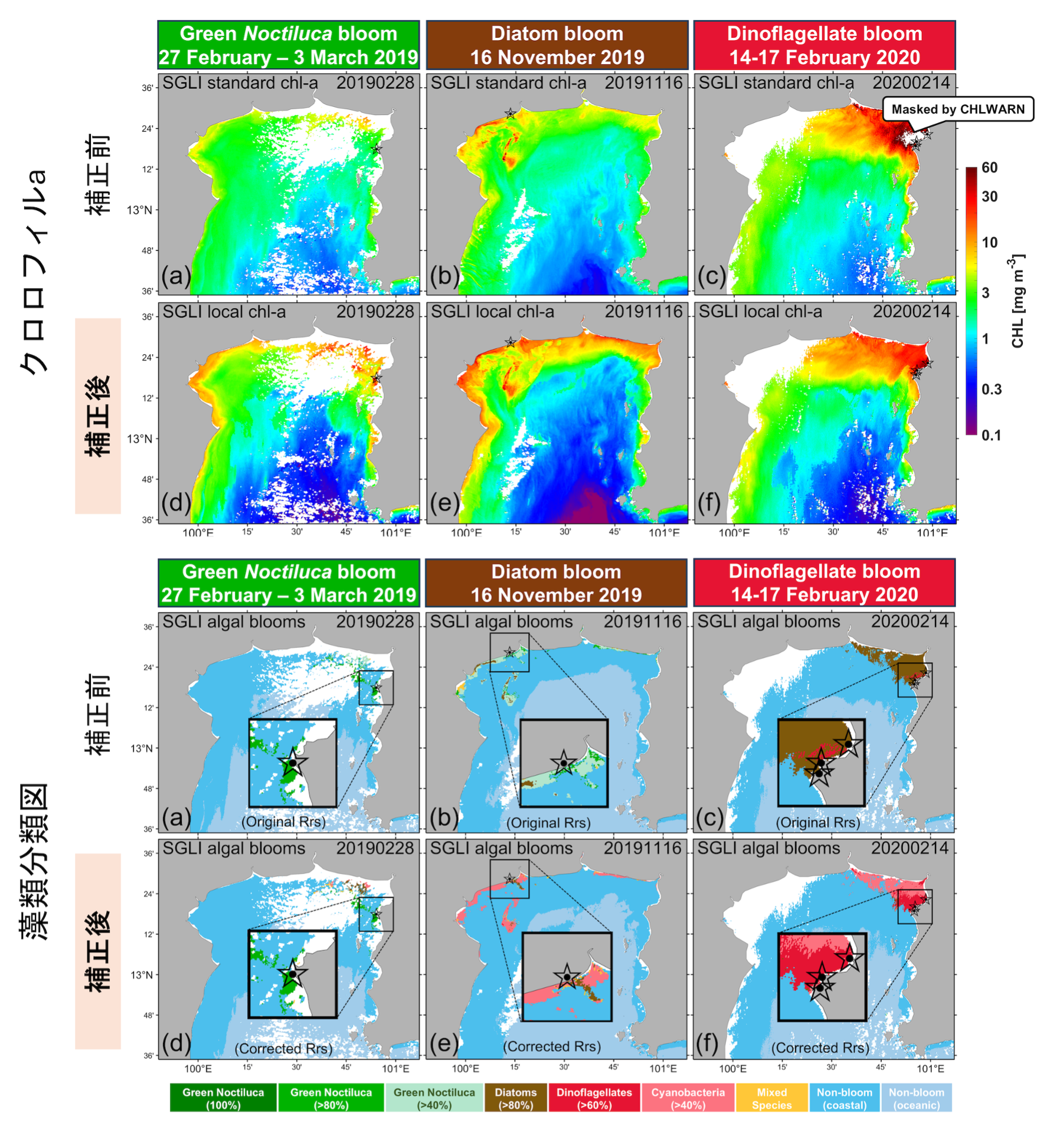GCOM-C/SGLIデータによるタイ湾北部における赤潮検出に関する論文が出版されました(B02班)
執筆者:ジュタラック・ルアンオン (Jutarak Luang-on)
本論文では、タイ湾北部における赤潮検出のために、GCOM-C/SGLIデータの信頼性を向上させることを目的としています。GCOM-C「しきさい」衛星に搭載されているSGLIセンサは250メートルの解像度を有しており、高解像度の海洋色データが取得できます。この研究では、SGLIデータによる赤潮の検出の精度向上を試みました。
まず、我々は現地観測データを基に、SGLIデータの反射率(Rrs)を補正しました。その後、補正されたRrsデータを基に、SGLIのクロロフィル-a(chl-a)濃度を推定するアルゴリズムを使用して、赤潮海域を識別しました。このアルゴリズムにより、特にchl-a濃度が高い地域において赤潮の検出精度が向上しました。
さらに、補正されたSGLIデータを使用して、緑ヤコウチュウ、珪藻、渦鞭毛藻の赤潮を正確に検出することができ、これらの結果は現地観測の結果と一致しました。特に、2019年2月にタイ湾北部で発生した大規模なヤコウチュウの赤潮や、他の藻類による赤潮が正確に特定されることを確認しました。
この研究は、GCOM-C/SGLIデータを使用した赤潮のモニタリングが有望な代替手段となることを示しています。また、SGLIデータと現地データに基づくローカルなアルゴリズムを組み合わせることで、赤潮検出の信頼性が大幅に向上することが実証されました。今後、現地データと赤潮の発生事例を用いることで、手法のさらなる改善に取り組む予定です。

図. タイランド湾北部における反射率補正前と補正後のクロロフィルa(上部)と藻類分類の結果(下部)
Figure. GCOM-C/SGLI images of chlorophyll-a (top) and algal bloom classification (bottom) before and after correction in the upper Gulf of Thailand.
【論文情報 / Reference】
Luang-on, J., Siswanto, E., Ogata, K., Toratani, M., Buranapratheprat, A., Leenawarat, D., & Ishizaka, J. (2024). Enhancing the reliability of GCOM-C/SGLI data for red tide detection in the upper Gulf of Thailand. Remote Sensing Letters, 15(10), 1096-1106.
【キーワード】 SGLI, 赤潮, タイランド湾
The paper on red tide detection in the upper Gulf of Thailand using GCOM-C/SGLI data has been published
Author:Jutarak Luang-on
This paper aims to enhance the reliability of GCOM-C/SGLI data for red tide detection in the upper Gulf of Thailand. The SGLI sensor aboard the GCOM-C (“Shikisai”) satellite provides high-resolution ocean color data with a spatial resolution of 250 meters. This study focuses on improving the accuracy of red tide detection using SGLI data.
First, we corrected the reflectance (Rrs) of the SGLI data based on in-situ observation data. Subsequently, using the corrected Rrs data, we applied an algorithm to estimate the chlorophyll-a (chl-a) concentration from the SGLI data to identify red tide areas. This algorithm improved the detection accuracy, especially in regions with high chl-a concentrations.
Furthermore, by utilizing the corrected SGLI data, we accurately detected red tides caused by green Noctiluca, diatoms, and dinoflagellates, and the results were consistent with in-situ observations. Notably, we confirmed the accurate detection of a large-scale Noctiluca red tide in the upper Gulf of Thailand in February 2019, as well as red tides caused by other algae.
This study demonstrates that monitoring red tides using GCOM-C/SGLI data is a promising alternative. Moreover, by combining SGLI data with local algorithms based on in-situ observations, we significantly enhanced the reliability of red tide detection. In the future, we plan to further improve the method by incorporating additional in-situ data and red tide case studies.
Keywords:SGLI, Red tide, Gulf of Thailand

